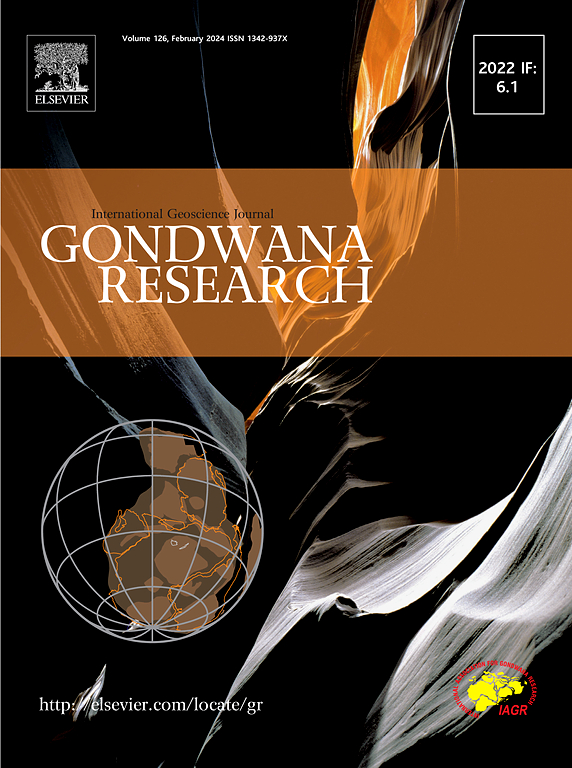冈瓦纳西南部早侏罗世和中侏罗世环境扰动:以阿根廷neuquacimen盆地为例
IF 7.2
1区 地球科学
Q1 GEOSCIENCES, MULTIDISCIPLINARY
引用次数: 0
摘要
阿根廷neuquacimen盆地的Sierra Chacai Co和Los Molles组是早侏罗世至中侏罗世太平洋第一次广泛海侵的表现,提供了独特的沉积记录。由于存在连续且暴露良好的露头,该盆地有可能揭示碳同位素事件(CIEs)的全球范围,以及测试迄今仅在特提斯西部记录的其他大规模环境事件的发生。阿根廷neuquacimhan盆地是Gondwana西南部少有的记录了Toarcian Oceanic Anoxic Event (T-OAE)沉积地层的地区之一。在此,我们介绍了一项综合地球化学(δ13Corg, TOC,主微量元素)和石灰质纳米化石数据的多学科研究结果,这些数据来自neuquaciman盆地南部一个新剖面。新的数据集可以识别T-OAE时间等效,以及分布在中托拉纪和托拉纪-阿勒纪区间的另外两个显著的负碳同位素偏移。六个钙质纳米化石带和几个亚带被识别出来,覆盖了Pliensbachian-Aalenian区间,允许将δ13C偏移放置在一个精确的地层格架中,并将它们与世界范围内的其他记录联系起来。新的地球化学和钙质纳米化石资料为neuqusamen盆地和西南冈瓦纳盆地提供了最连续和最具时间延续性的记录。此外,这些结果支持了T-OAE的全球范围的CIE和其他早至中侏罗统同位素漂移的存在。这些发现说明了有机碳稳定同位素与钙质纳米化石相结合在重大长期环境变化中海洋群落进化的全球年龄相关性和古环境重建中的实用性。本文章由计算机程序翻译,如有差异,请以英文原文为准。

Early and Middle Jurassic environmental perturbations in south-western Gondwana: An example from the Neuquén Basin, Argentina
The Sierra Chacai Co and Los Molles formations in the Neuquén Basin, Argentina, are expressions of the first widespread marine transgression from the Pacific Ocean occurring in the Early to Middle Jurassic Period and provide a unique sedimentary record. Because of the presence of continuous and well-exposed outcrops, the basin has the potential to shed light on the global extent of the carbon isotope events (CIEs), as well as to test the large-scale occurrence of other environmental events so far only documented in western Tethys. The Neuquén Basin in Argentina is one of the rare places in south-western Gondwana where strata deposited during the Toarcian Oceanic Anoxic Event (T-OAE) have been documented. Here, we present the results of a multidisciplinary study integrating geochemical (δ13Corg, TOC, major and trace elements) and calcareous nannofossil data from a novel section in the southern part of Neuquén Basin. The new data set allowed the identification of the T-OAE time-equivalent besides two additional significant negative carbon isotope excursions distributed across the middle Toarcian and Toarcian-Aalenian intervals. Six calcareous nannofossil zones and several subzones were recognised, covering the Pliensbachian-Aalenian interval, allowing to place the δ13C excursions within a precise stratigraphic framework and correlate them to other records worldwide. The new geochemical and calcareous nannofossils data provide the most continuous and time-extended record for the Neuquén Basin and the SW Gondwana. Additionally, these results support the global extent of CIE of the T-OAE and the presence of other Early to Middle Jurassic isotopic excursions. These findings illustrate the utility of combining organic carbon stable isotopes and calcareous nannofossils for global age correlations and palaeoenvironmental reconstructions in the evolution of the marine community during major, long-term environmental changes.
求助全文
通过发布文献求助,成功后即可免费获取论文全文。
去求助
来源期刊

Gondwana Research
地学-地球科学综合
CiteScore
12.90
自引率
6.60%
发文量
298
审稿时长
65 days
期刊介绍:
Gondwana Research (GR) is an International Journal aimed to promote high quality research publications on all topics related to solid Earth, particularly with reference to the origin and evolution of continents, continental assemblies and their resources. GR is an "all earth science" journal with no restrictions on geological time, terrane or theme and covers a wide spectrum of topics in geosciences such as geology, geomorphology, palaeontology, structure, petrology, geochemistry, stable isotopes, geochronology, economic geology, exploration geology, engineering geology, geophysics, and environmental geology among other themes, and provides an appropriate forum to integrate studies from different disciplines and different terrains. In addition to regular articles and thematic issues, the journal invites high profile state-of-the-art reviews on thrust area topics for its column, ''GR FOCUS''. Focus articles include short biographies and photographs of the authors. Short articles (within ten printed pages) for rapid publication reporting important discoveries or innovative models of global interest will be considered under the category ''GR LETTERS''.
 求助内容:
求助内容: 应助结果提醒方式:
应助结果提醒方式:


